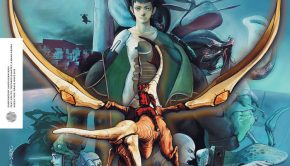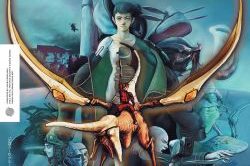Mariko Nanba Profile
 |
Also Known As: 南波 真理子 (なんば まりこ) / Nosleeves |
| Date of Birth: June 28, 1971 (Chiba) |
|
| Residence: Tokyo |
|
| Game Works: Sonic, Panzer Dragoon Saga, Billy Hatcher |
|
| Official Site: Sega |
History
| Organisation | Type | Tenure | Role |
| Sega (Sonic Team / Wavemaster) | Game Developer | 1994 – | Composer |
Biography
Mariko Nanba is a composer and sound designer at Sega best known for her work on the Sonic series. Born on June 28, 1971 in Chiba, Nanba became interested in music at the age of four, when she took piano lessons, and eventually pursued music further at the Tokyo Conservatoire Shobi. After graduating, she sent a demo tape to Sega and was recruited to their sound team in 1994. During her initial years in the industry, Nanba primarily worked as a sound effects designer and sound programmer for a range of productions. She learned the ropes of the role while creating the overseas sound effects for Panic (aka Switch!), a point-and-click adventure title for the Sega CD. She went on to design and allocate sound effects for a wide variety of other titles, spanning kids-targeted productions for the Pico toy, to mature action games such as Dragon Force and Skies of Arcadia, to the ambitious life simulator Roommania 203.
Between such roles, Nanba nevertheless received a taste of composing while working on Sonic’s 32X spinoff Knuckles’ Chaotix. Even in this supporting role, she demonstrated considerable flair and matched the light-hearted image of the game. Her subsequent responsibilities included the background music arrangements featured in the Saturn RPG adaptation of Neon Genesis Evangelion, as well as a range of roles on Sega Worldwide Soccer and its sequel — among them, offering arrangements of the numerous national anthems of the featured countries. However, the artist’s popular breakthrough came when she was asked to produce the music for the RPG Panzer Dragoon Saga alongside Saori Kobayashi. The emotions and colours of the game were enhanced with rich, intellectual compositions blending acoustic, electronic, and ethnic elements. Shifting gears once again, Nanba was also responsible for the anthemic score to Let’s Make a Pro Baseball Team! in 1999.
Now a central member of Sega’s music team, Nanba frequently demonstrated her versatility by becoming involved in the company’s attempts to explore new game concepts. Towards the end of the Dreamcast era, she led the scores for the online theme park simulator Planet Ring and the futuristic rhythm game Space Channel 5 Part 2, offering a range of upbeat technopop and fusion compositions. Nanba was subsequently appointed sound director for Billy Hatcher and the Giant Egg. The artist filled the score with endearing pop-based sounds, while still considering the deeper aspects of the story. She placed particularly emphasis on multiple variations of the main theme in order to offer a hummable hook throughout the soundtrack — the vocal rendition “Chant this Charm” particularly demonstrated her talents writing theme songs. Following this work, she took additional roles on Astro Boy, Feel the Magic XY/XX, and Touch de Uno! DS, maintaining a flair for writing youthful and humorous compositions.
Given Sega’s music division Wavemaster could be contracted to other developers, Nanba’s talents were occasionally sought on external productions too. Generally more in-demand for her lighter stylings than her Panzer fusions, she matched the oddball universes of Exrays’ Super Galdelic Hour and Artoon’s Blinx: The Time Sweeper with frivolous scores. While neither project was particularly successful, she still embraced their interesting concepts and tried to complement the artistic vision behind them. She subsequently received the opportunity to work on Yoshi Topsy-Turvy in a smaller role, which proved another fine match for her youthful personality. Having also gained the attention of record producer Shinji Hosoe, Nanba was asked to make a guest contribution to the original album Swinging Circuit under the alias Nosleeves. She returned to Superb! and Delight in Daylight by popular demand.
Despite such colourful highlights, Mariko Nanba has dedicated the majority of her time to scoring the Sonic series since 2005. This is largely a consequence of Sonic Team refocusing their efforts from new IPs to regular iterations of their biggest franchise. Nanba initially served in guest roles on Sonic Heroes as an event composer and Shadow the Hedgehog as the creator of the Circus Park theme. She took a much more prominent role on 2007’s Sonic the Hedgehog, representing diverse settings and key events with mature instrumental themes and the vocal theme “Dreams of an Absolution”. The same year, she offered some worldly fusions and catchy melodies on the DS platformer Sonic Rush Adventure. The artist combined inspirations from Hideki Naganuma’s previous score with her own lively stylings. Her services as a composer were also sought on Mario & Sonic at the Olympic Winter Games and for several stages on Sonic Colors.
Nanba received the opportunity to explore novel territories once more in 2010. She created much of the background music for Super Monkey Ball: Step & Roll, which proved a very natural fit for her quirky, rhythmic style; to match the development of each level, the compositions were subtly layered from minimalistic origins into rich fully-fledged pieces. That year, Nanba also reunited with Artoon to lead the music for the pinball-inspired action game FlingSmash, developing a light-hearted jazz-tinged score in her signature style. Nanba has also continued to develop her talents as a theme song writer. She penned the ending themes for Sonic Unleashed and Sonic Colors, “Dear My Friend” and “Speak With Your Heart”, which closing their respective soundtracks in a fitting manner. Inspired by the success of such themes, Nanba also penned music for Sega’s original album Girls Make the World Go Round. Though the majority of her recent contributions have been light-hearted, Nanba remains a versatile musician who is capable of matching all sorts of ideas.
References:
– Various Game & Album Credits
– VGMdb Discography
– Official Profile (Japanese, Archived)
© Biography by Chris Greening (September 2010). Last updated on January 26, 2013. Do not republish without formal permission.
Posted on January 26, 2013 by Chris Greening. Last modified on March 21, 2014.














